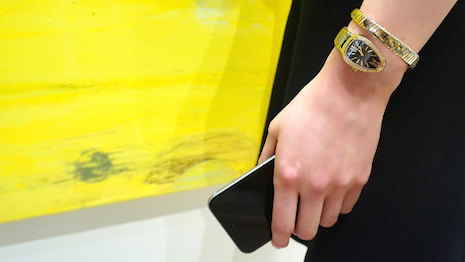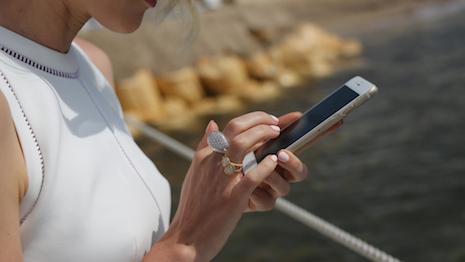Mobile shopping transactions are surging as consumers continue to reach for their smartphones instead of desktops when browsing online.
Retailers who actively promote their mobile applications especially continue to see positive growth as more users embrace in-app shopping, according to a new report from Criteo. Bricks-and-motar retailers, however, still lag behind their online-only competitors and need to better integrate online and offline efforts.
"Today's shoppers are active across all browsing environments, and they're buying more on-the-go," Jaysen Gillespie, vice president and head of analytics and data science at Criteo, Los Angeles. "When brands don’t have an app strategy, it becomes difficult from them to engage and monetize the fastest-growing population, which are mobile shoppers."
Criteo's Global Commerce Review is based on browsing and purchasing data during the second quarter of 2018 from more than 5,000 retailers in more than 80 countries.
Smartphone shopping
Globally, mobile purchases — completed either on smartphones or tablets — jumped 13 percent from the second quarter of 2017 to the same period of 2018.
However, sales on mobile Web browsers alone propelled that growth as they increased 48 percent year-over-year. Sales completed on tablets and desktops decreased by 22 and 18 percent, respectively.

Almost a third of online sales in the U.S. are completed on smartphones. Image credit: Neiman Marcus
While mobile transactions account for 39 percent of online sales in the United States, mobile purchases dominate in Asia-Pacific, where they comprise 51 percent of digital transactions. The Middle East and Africa follow closely behind with 47 percent of online shopping done on a smartphone.
Retailers who invest in shopping apps and their promotion are seeing positive returns. These shopping apps are especially popular in Asia-Pacific, where they make up 46 percent of online transactions compared to 29 percent on desktop and 25 on a mobile browser.
Adoption of apps is slower in the Americas, with only 18 percent of purchases completed in dedicated mobile apps. However, the investment is still worthwhile, since in-app shopping sees conversion rates of 20 percent in North America compared to 11 percent on desktop and 6 percent on the mobile Web.
"Smartphones are ubiquitous throughout the Asia-Pacific region, and the ways consumers use them are evolving faster than ever," Mr. Gillespie said. "Apps rule developing markets, and app usage is growing in more mature regions too.
In emerging economies in Asia-Pacific, where smartphones have become the primary means through which the internet is accessed, customers will turn to shopping apps for convenience.
"The majority of smartphone users in the APAC region have between two and five shopping apps on their main device," he said. "Convenience is the key driver for installation, product range and ease of use, which are crucial for sustainable usage."

Retailers need to embrace shoppers' omnichannel habits. Image credit: Bloomgindales
When retailers promote their shopping apps, digital-only brands still outpace their traditional counterparts in terms of app sales, 31 percent to 21 percent. However, bricks-and-mortar retailers have more opportunities to integrate apps throughout customers' shopping journeys.
For instance, Boston Retail Partners reports that 46 percent of consumers across all generational age groups use their mobile devices while shopping in-store to compare prices, check inventory and read product reviews (see story).
Digital crossroads
Luxury retailers are not immune from changes in shoppers' habits and their growing reliance on mobile devices.
Affluent consumers are increasingly using digital channels within their purchase paths, with a mere 22 percent starting and ending their journey offline.
Ecommerce sales of luxury goods are growing rapidly. Today, online sales of personal luxury goods are $20 billion, making up 8 percent of total luxury sales. By 2025, McKinsey projects this figure will more than triple to $74 billion, with about one in five luxury sales happening online (see story).
According to Forrester, over the next five years, mobile will contribute 69 percent of the projected $19 billion in revenue that comes from paid search advertising.
While the overall share of advertising revenue from search will decrease, it will remain the biggest driver of digital advertising. This presents an opportunity for luxury brands to capitalize on mobile advertising and the unique capabilities afforded by the channel (see story).
With their growing purchasing power, millennials are making more apparel purchases via ecommerce, while baby boomers and Gen Z consumers are pulling back on their online fashion spending.
According to another report from Criteo, millennials spent 4 percent more on clothing and accessories online last year, showing a greater preference for fashion ecommerce than their younger Gen Z counterparts. As these generations become a greater part of the luxury business, luxury brands need to be ready to meet their disparate multichannel shopping habits (see story).
"Our Gen Z report just recently revealed that this power group of shoppers spends more time on their mobile devices than any other generation," Mr. Gillespie said. "Additionally, over 50 percent of Gen Z indicated that retail websites and apps are more influential in the purchasing process than search engines, online video ads, TV ads or online ad banners."
{"ct":"x1zahLF7CQqlDJWgu8xRm4ZaTiDpTUJjYlqwGQ4ku1gaoRN0NnZ8p2pTVlANc4VglpzYOcW3ILO9uhf9EWVmEjXei4MHL7zogQ8vEHQcQ1pZHnfB+QIfeYG+SrExqVIH3ErK5wayywtyp720KVb1D1KUIobAiRf1Qkgy4wlODtpsV9p5d\/qJZjB7Y\/Ha8WETHKwN2eCf5Lg8YUOLFQMhqSHQ9J9grn\/4s3fS3wlGJJnxuJg+NiGKn75OMGDrmIkk5tSyFO\/MSJ4fQ1gM6Q89Jrvv1jqGXGSZiWSzb+y0BJ0613AFUypojlBdOPFKRZrqJLTV6+vE3NfgA0c5SM5mWJIOp\/8h80e4F9pMbtpxEuPYpomAo7U9BQ5hqDbr2pP8cDBQ7DCYDD0D2US16dDKQAT7ugyqDru5F6K7Gk6G6Mf8f9xJ1YRfCWtFwiqDusq73aq\/yffcNI\/8Ub5QpZ+8fnbfle+9X2SG1SgDFf4ZRzb+pCyiyiuLENvg8eZcYEzFIMdIUI6tq16EjX9FyjD8ftD1LCOp0\/L8+QyOoiUwaS3Q0obkQZeg9uTX593rullMxHszqKM6iplo5dz3PPiudUCdB4GMefA5nMqESubVaGrwwpLQjzuODBoV6l5PEBOnSPoF4FxO9CyHsEaGNtQ+oYinrYTOeBSOjXhNg2tmfr7NRx5nSP+ay09Qp2xyHa8Zx52J\/y7xQZmSERo2lIKIc0kI9rBy18naLBA6b47v7DPdmzdsSSGmWL6K372P4UOQncwAcRvkjr+7iJKds++jld38zC3fvzjbJykd9j5IPFSVOd3e7na9hSfoFFOGJ3PKXgVGjhIee1RS\/klbfl+j12dkPUpyVQDicgGsKtBlhnmRfnM0eUAfpmISM2zDu5GHpRpC3PD5Q+cOR4fXychO1mME3bQIsoBwsFL9Xz9PNvr2LDRtD3blljA\/mjaRl4mo3NJi4xGnMn7tTdyrJviZfaCbzKHlLpNP6R+YfY1BdfkE+ob57GZxBwYJpHM6dbXHTVzrb8w1NAEDN27Cj163sQnAt+BzlW1lrSZzPzLrS5WrnhBrwEOQ29euVKw5CYwgEnD5XFYqVaPP3xLW94w\/CdV9Vwgb4x+IVM36OxGTCvBauBQMUkebFDIV0aObdzQ8pnah6p5Y12FcoLz0qunL0f5Vfli\/9AEge3f1DOSBGx03EPn0hiY8Ih62KlLgRBANcx6twYNDLJjcoSTrJIJMg3dAuAiSXZlHqOWZrkenTH1+1lwbkYRFnOCfXptazrU5oLkrk3Eb6ASKZtZ3GyAfeIUWoZI73\/Peb7zy+ce3Mg+RQKo5nfphZAvX40JLaq0RG+sueyNyF\/vCuNnOBsxIVJNFxNHAVMyO+GQthZ4CK1CuE8NUOvrW3WttmWN58yVo+Z1MJiqEHUL7Sa20wwuJc+lcl+3zVaOGPFrkQ+3eesU4afiMMtXZWT5FOJLrq3OQQFi+fgX51ULiq93bA2evhyc8lZe1nwwbXGWqCyOEGqouPGBO3lj72FvPqhQy+vEODxvUyLG23M9KurRbTkhUpbRaFRM826OqErMF2UVxZU72CaA8jmbyi0RjxDlLt4bnPQIMfOh6OP40WBIq8FV2dgQPFYk8leQdKaE0UfR5vP\/dKaX3aIELt3Yqs++p8VLPQHPoeBYt5\/9rziEljpArXOLR2nacCXElT1wT9ghFWmb\/mkx39SBMXiOdxqmnlJCcTBZmLutsfHByKoqdRhZqM4pbh+x5GGkGoFVjnOx2GkbVPKUPqTxK68Z78qflnyJKFNkHwtaUOSWPWJd9HGnvA9w5BdsKh+GsXgC4yvL8w8rXGcw\/wfd5MR98XsSdotjWuY6VWh7dJHtUuiZh7NoCwxnulgmVtlQ8wQKKz4eJMFDekGWV8S+jdB2ZMMHsb2Oh8jbTCkVgaEUDvkkZdBvb81MaQj5OUdVBSyQx+0wJhLmq4Xw0yJGXMogLYfZWtnv6S5XGTpCIUKvEYfMSh50j3sFg7ziYZSe9PYwsHtmyFtZETvrN75ODex4bOcS7zF\/vgvcM29ASjP+5yjaAlyE6yq64iHNKJ3BNKxKdVv1EZUCK0CENk7kuqbk8vIVZDFY3HCF0MsMwc5Ofj+8+kgwReU91HesLsf8AWSM3NiY7QbFzNnGJsovkpf8UD624xCh3pyrHKbIelpNJdAQR6VJ8U5dmespSjH+ARBVGM9qeMMMSNIRa5\/ScbNw2yWI+GR28Wnv4OCWwyxb0qrSYZBLeB0AyFdeeQHYyiCutSc1rbr4nOebjLVudkf+YRUQgtteD3xfozkSMVUK0B+pvXGTaTn4655sZR3Z9rUhH81xs8z\/k67j7Qtw8pWlt8iumobLVrGJgNwszOD9N3LlMCcp2mWA26IwmYFX0gxF\/NVF4WRvx2Y0PTAa4vmQX6zjNeJjG11yrGhiLvXvUjYkI10d5+ub4jo\/v344dR6NelrlfujePNqwa99KSK7Cee+HXqiCNXpOk0CpLPYue7yhFoFSIKjGkVxeDmQ1ADt1H3MR8CTLEzhHelRTVRWIl8TuQ5mgTZod4kz76Y9QhIz65ZdjPpFZ\/Iev3UrxD+UClTRgkhBSwKRMNm6S1piuTlOAkCbUXY2svK4YvFhVebqnu5HvTPbIVBh6o6g\/H8qoGhcteSvJnMGu3yGsZE+tHBCEtae\/nktiU44qXomfGqLLkSUijTpQWfi\/2UrPii4rvBdv52BfplTKyTDCeDuTXO9GQVm1Z6Y4nUHCGM8opMa+rDxmw3cNT\/FyFOGTiUvamtUhmDfDcosvBwtOlI11GbojWGNHtOXaR9npjBb6r\/49Rlyx3oB7ssTJfhh+YX9O+X3\/ZfR5E3kONqK72Y5VmGhKKsvj3SvCsii4jAXJlzxjb6EIa6Pg1\/jiE8TdMYcqBXmzvZmdsoBZRfl+dtdPlufg2H5eZcjKmVJUyOFFp1mLkfa3z8U2+i41FK15ncCL8T\/Zgy7wMLHYr1TZcaFZo+TQ4pg0r9G7HiQGaqE47nt9S9mLWa0D4w0fqmbVfcYW9xGi6Lr2AYvpk44Dnd2McK4EAQ7tpW2D781shoSZW1FQMI76CSkFaUOEaXUkvKhGs\/nohlpkGgztchJmSP9rbbkttW8L6bTqBK63pJQS0X8oOsdPSesGOlpwFa\/F2Yxa4XNb3UVOmMtxMkGzAfnOwF2c3Sax6qKiaspPB4Em7UjmiBQ6g6ttNDA2yTr5lXE\/7dpYIrulpub8iom7TjaMRqAo6C5+\/4Mx3+b2KrCWgCLQc53pxugJwewz\/phepCFtpWjVzun6nvraAhWX+8NSFyhKeood\/bmB4KYUW+VJBH9w37VwR7lIUXq0aotGTRHpGqqE\/BoorUZUqHYYmhh9igaz8tITNJJ6KvqGxnI326YwoYCMZo+3OkqHkmoN3mPtg6fsJDR7ZnlprpdX7xXtU4sb1wIVqQl2YHfjjTcyScOcM8\/yMregNrtdM0+VMGtkXWpWurmZrfvi6ccMGdCrRe+IPBa6qVYo+nVIjaspSRH0kK8i+3COVq6ZPFvaOq1GcCGVwrDXM28hzwBIIvjYNDBZIvCKGPnJzlLLZv2t7D3sunu5C7kF\/AHP+8wbFD\/gWO\/VMNCnYVVc2Ee4PMFLMxO6CyVZnfo2ihBeTZzq8U41wZnhNwNA5Xqu9\/v+UyDK4+EuuxwMJztzZLpbUK3U92P1ZuS4xi1ZqB3tbq+ArCHqwurhf0KMPMYqTYczqoXdkweiTWPFD1G7kRZbTXbWi9NEFdpdYRE2u8l7GrWIb2byix7ik9Cgze7Vr62qRkgAloj1UD2VdWXdwGR54jJFZmeSrv5ltcfVaKl8nZ0++ke0u\/B9nWXbn1s9Afqx1B4PyIFk0KuxJHEM2jFWyoaWBvDdlpOEDjGt5xPjngfeanVboTlI33bcWjzKyotXqhPitHNJihOW1Q\/n\/BP+HeROR1xdWddPoc1oV7annz1Gp1zB5O7Bigzh273zkdxs\/0uaBe0s0Fed\/CGRBJruWvnulfpb3Bzq9CCfQXzXn8NxDc32\/Xa2gDMsH3xag6VA9T99D50oARRNZnjTpUkThfRP5D1eDJGHIAuaeq\/69C6bBrUFxtFmCbpSqIGYdDEuzzkcowg\/IHxigdQ7omnAD9Tp8HdeXjAfif9ooalzvazjDRGwo+ey90clIlsTPdeN5FqBIQS5zJFQHBjdkwCe7IpU2yu0YnVdidV4swPG\/JYUauIdNgJeq9wuWf8C83TH0aPJpeKu6NNOX8IqckAomH1\/VDN4H13vmtyeFWb9j6nxILluG22TJ7RE+nMmKeI1aO\/NYyASGalt4tUudvFSEHNScsPKu9I9EDmYZHn9q2c845nXUuuaeGql+mmidMQHY6YXBbKkBi3RgCNxHX8VXWnlWuVu0oo\/Uzb3Q2SyR\/mVSrsNTJfekoImpwTBr9a01mr\/Bwbvm7UH8ou9EB0OqeGYVowDNFjEccAeGdiDE6McAJCJysv8ap96eGz37lB\/jhzkYLnv5ZDmeUh\/2WiL5CNYQeGrexxsnHmQv2ZBIcI06SvdByoll9Hn4RO9M5LO92+jRxWsM2p1NfyydnFksA4PZU7x2PBlgXpPAiH206L7mTcxFk+tWPQYaBmQlSHcXDRXIM+hUmMt2jYoYsFzBQvWC0STNh0LIWpGRcly0dlsObKUlft9sWyoweefFUjvuwcEcbwhLUcfH9\/MopOjT8zZyUuKgrRdbzCn+9KW1we5J9Af5X7yLiiTA2Km11RckIZZy+EGntKKgW+WDfxlUBToERQHHaGTpQ0OJF+bPC1Ccj4dSrZ+lzn0i\/3LCLbmSDrtCI4pz4m3OTghpawhU6sFUejAX65K2QoqFxQPesbDml+Pdz4rgEchvVy\/UbgLCY790wPcQlz79cxVJTovdfJ1lgwpQdtfWhcJN45AdBORIMf2yOqSSLWYO+vYt9z4\/dXjd9G46kpAFEtaAzqpszl7Sre9iI3zcwePavnfbx3R48nGeT5B\/+\/de0W7OsvJ1T\/eRRhjTQDcnzAuYdup19Bd61qOBg6qpzhqafIXYfI55PloCzk4NDvigGo8Pc\/nGoz6UUaGFYqpOrm6sAiBmXhB40C6EhF0OzthUTK2M6kki1xZtdG718JALDIQ9xKv+kD85SFlt2gyE+zC0EgjCMD6R9sBZUNQzofOCWFH5aNNgOzUhvgijSeSvmoHe+sWd81QjveORXt37LI4yg1DiBAmVwWIeRObRzHowBOnQX1Mt+qRof2wjqQ19HATc49BzGi8TMLlV7KDKtccYzHrH9mPMx6iturMoJbNAKKDJ0Tbnz8HZ7\/4HXWRKCKwMOCXuvHx8IGPgJAtnbw7ylXE9eB472KcnWIQPp6L0ajczlBkW1pnqCYnH7BdhPNovnLAorBl8N1h6UvkTBXTszBEcct4vt3GwLgIJu2AkXwcrAM0kb8QK+S3aw6tewopbBMWOpNULg0gCPx2hEx5bvWwIPExh6zPe\/8pZ8SnUuhsQUOfAl8qtwC9BaL1kVB5yeLFVo2KryLaUTXq0OxCcyBY7o5X60Fg5ootqRRaTOaMDiLme\/3yKLPpV80Ls3vZr9lKgc6OD76iyE82heduIRDwTxwg1O5nfKPB\/2hZMsgbhWvGGi4HAn2UXcFMCTpuevBbBymohY7VO\/GE5eJDMmd77U9I117QZcRAsLCqNlCTySnJq4yN\/3VorIHUvSC4XHjwXAtSXwpZ9xdLCcb2JKXyHuwsiBgAaZrKes6kovKcF\/lGrPLzoGJct\/SFr\/FAqKIN2INfytT9i7XeuAr6CXMAqlSM9BVYY02+z2ttkAbRzIRg5RHamxvekJbmA8VVzr1TxZhnonyAaezqKR5w96fACdYDBPChvfhg3RJykHbHSzlpN6YbZcqvJCO27fDDC122RA2k+OigT1117IwtTF1JC6732Wr3QSAFMDH58xZgLT4OwyfTJaQbouznO69QDD4icnP46LwPDN0Re0C6nFqvN0braT9Ss6cx5RTZUEimAX6K+opXtehPIWLoHfrb9b2jvWQOvdkZLbiTfxufwObSROT3wki\/qkCT3jHAL\/C4csetpcLPwTZ+Hiwifrhs31k10pU\/rMtxxX1GOI+11WDojfSK5oH2CcrczQS+sNaH7ZOapftyrDJNfRZNNPQuE3LLAFGeZYNkZ5dxYeY0dNW2qhr9fmJhivyd8Vm0epD\/wW7Bl3Kn82jyc+DOyBfQr\/aNTlk5VlwCjo0q5L4IXKk\/rXl51VohBNUId9i9PrmwOVxdx2LLn3kpHgAKHKRuCIyZ+lcnE7H\/DmTLuMl+9j3eZRBO0gSRaxbGBt80snuOxLny+AnJ2H4ruov8ILdn1FD\/RWtyujb\/thZ\/038RV3oVtc1SFi3eP3Ibb7WAai5mCqAy6oXbmacMuNsszGwsD554SOho1yQCy5C8RZnET53cI1seKlIXnrR7nw\/hK4qBnFF5rmQM\/r9NQht3mtyEjzmutztGKD1iWr3k+gk4+SgzjDI7c34676uwIhVZm4eyzyxMF3bn7D6hQ0\/zGpf9G9ZmzaCfOTQrPB+6Am\/RQ84oekEEK1juP+TJOQLMmNpvbpyhxlobXT3yjkJH3iDTjIKXnNaHhk+5hQULeMxjKFk80RWRd+eu20NsynNtyng687ow+aFbBg\/Tf486M29BmrrHjs8aRU7qq1fid4XM+5TmJdW60oBUFi6Hv6nMb41kGMPMmxMKofGQ0MFJDcqb5dyq0KKYBE3RktiTEL6aviOW0mKBWF42o3vrBwuuGf4AZOyRIri+IrtnbivqDwi3VGBywgRPuSe8lY9edNqw7qtVyN1EByDPFkXNoYuo8uTEMp6P7HeJDA2avvhFdr4RixAKyS23DKkjfVke6KqG4Uo8cmquyXNW1pOw+IlOufAQkfIDhvFIaZvRIlqu+3z79pa0ktl1nWSV2jamk4PeZ+PA1ovIODQDm0JREaCxiO1+Z7IAmhastzo2vHacSwfZ9EStskoFYsTLSZyQ4xU1ro\/S5Wwfd2h\/fGO9mdceK1mMYFUIhYe1V1p1kcmIerA4LpFKvni33rMdVtbvJtQ0oDghSyUq4M\/jSllKLLumAc4N1OI7if046t8TWXoKkmK3ysjCTO9Ng6zRna8hyb9ITuGOKJMbWAo98tIlAGEscgeaNGDk83OSMf6LlwiXr\/9tPxHS3BFViBbvwe9he5+lPAG5X+PIUTeuxRIzfldi2q1OZkndqeIkAvrROe1rQlck1nPSs1oCrppEQM2uYbh7aVtHse0y+FGtrQRX9g2iwUJW05\/xv8kFs4\/wj5WT9IUDj5\/YKeEEDLgyQQxhuwA2ryWMg5wGGtRL+xlTWxRbinXzq3DAnblsGVKH3ehncy3jgiTLh9cJXlHuwjVrZ8j6OCC6PkCDA6r7M\/KlIx7UkLU7gSmc+NjRTKM8WvimT0BcuHIGSbZ\/enx3E9JoAmNERGz8lEX3CpXrEXAgzCa49YU1H1CqIfCy+5kLztFhMTkH314vIEJ9EePLXMNzbFzL57GMQTiDET9n8KeNgvaUrJIFIoHdk6UAjNDX3klRvBgkV8gxwLNwNV7mMJIZmw8vXwMmOoUZamb4T6Cye6auU4730CfKzuan2xR5hgOCawyzWbvLwti2q0jLTzkDncWu7zTuQQQk7PxkMHfAjcYtYed0KA21j8iirDQuZv+fL622jHV23BaLwktO65zK1M09kv+D6tFx6paapBh0mWr4ILuR8KtETTE3aPpyQecTqluIDYfJ1jTV1GsgUlB1xWIXUt8Bu953pgobwSxu6UowMmuL9H8LWn0CzBfzU90IeQYLegkC4HVn7hZuUOuiAcEwfM5fqRDHpPcJh4rw3zzecTyCIDqYE9TkyWk8lM+FMlCIDbb3hCBagpMv+AdiOC2AajvmCMfXW4433LN22JxaWD8uW5yA4yLiP1YyY1\/woE51GobK0nj\/Kp1Kwhcr2uVTrWPajKCeuj+fK4ti02le+me6cT8BBCaqR8i1jSn\/ubIPX91LyXoylL4pipZWvP46d9i5SIaOgh6zdqayQr9aKRO3G\/Hq5mgLdK9zd9UFnDxGReOMoEPld5XWMr+HmHwjlFhH9Tyi1plWF9FlGhD9FtUF7P3nlVSE7AANAClR582nJxCxzXM+0HmI95qaPOwLzQyunZ8DCv3CvKNO0IyytZ1yo6Yfm\/z3iTgJKpP1F9dapiwdaFc1fuUEkggiG+SRX38X7ECrthvrbE6AoZCcgbTsQH+8IiJUI5fzcYs7X3QumzAJkY+uly7ZTf84m4qHeaC4Nx8YM1ToxdnSv1WpoF5MyWufz0diMa4TyVQMNoWUrutSeQZIAlAMlnDXSwZuxNEWnqiw3yntlltO9HKUme+\/vCgY5a6vckz8IhzmQtr59fGRvVlzacTmAxecXmo3szNCD9JfuxdxBxVSa3Vw70NXV6DRyrYdKldz6B4adkf4whqL\/z9xO998q+W84lMo9P4sqth93IMBgOxH7wXPilV7Hb0hAbMK3YEbdYRC+hZMtjUeX0mfYoTIvrnx9k3y46Pme73WuvP8eEPoueHwdULipGj\/13BGZPRnB3CTqBy\/NjpEEKbqgVjm7g628Wji+T72Phw9eLo6Qd3AYkNqHOLsVSnnoCFu7bWSQWyk9lwhkW7LNGy3lZwdV7y1D\/K3Kxo9aBpT6kAUj9Me0HAjrFx7kUaNYuDoVNdLfSRYH5KkYfa9bXDaINjocBp+e\/ZrdAWrR6Wq1FfIbzhbCrLqGUOho9d1VSI4JV59L7uMtMs3QPEFvnZfEw07ARYV2j5xiQkjwMKd2jyV18g4J\/PLJDfxRNef4wfgqJMSXFYYX2vCYhL+h8FqF72taFuSrRo750KZEEIR02r6pmR9ZUSbxhKv7uWnxtxzXqarlO9gwTxWBU78Utl0f3fTI5UsK7REWdGWJ\/FzrldYBjVMBqKbFvxmSwUlhiRYJGaGKkR1d6MTKDirKBL9sj61pCv+m+xgvlgZTBQLJpIBumLafleDLogr7ovn8PUwvgR66tWkOQkqBuMzF8e7mSkZQYVBZD8K5cobt4P4GUAN38bZoKQA0Kh1wVJyZlPRjXUh4nXB7G+Ly7XI17qJ+UL289lOBOdtFSU2VkbJ6WO7AsvlXvzGPFvEs51YBdrDmTR7h+KsJ96v1+6mzPzuxlG4ZmRG2HZQzXN4cAPtf7GCbIZSw6KK5RLu6PuzJWFg9bV1koE2xr9hbUjkweCWOmI+JKi6lqz7YIcCUDab2QbPJ9\/c2YxiiT5wH\/wd\/OrRd\/NI2YpLWQUum9hIN6N3Q8Q7YcO\/ZN4p4Pc9gw+t3vEoqGvRfuFvdLQCg1JDNgFDWKVcd7nZNKZdbsa6s6aCTRMqNsL5JPJhgj14UCRhkHKSKPLtPpj\/DuJLzxmYNdFR4aVbZvV0RokAXMh6svxofSeVPCgGyDO2WmF\/Rg71G1b4hngP2UKQaSpcq3ZQl+ydHuaXpHA==","iv":"ae7b84b1489fb71a4104abe920663e8c","s":"fcfdf3d6b40725f0"}

 More online shoppers are turning to smartphones rather than desktops or tablets. Image credit: Boucheron
More online shoppers are turning to smartphones rather than desktops or tablets. Image credit: Boucheron